
227 – “Billy” Charles William McDevitt
Charles or “Billy” as he was better known, was born in Esperence, Tasmania on the 12th September 1886 to parents William Henry McDevitt and Caroline nee Bentely along with his brothers Albert, Edward, Dennis, and sisters Agnes, Lillian, Irene, Amy and Beatrice
Bill’s father was a carpenter, a trade that he passed on to Billy as well as his brothers.
Billy McDevitt would hold on to his trade skills throughout his life , but his true passion and his eventual path to world fame would take on a very different form.
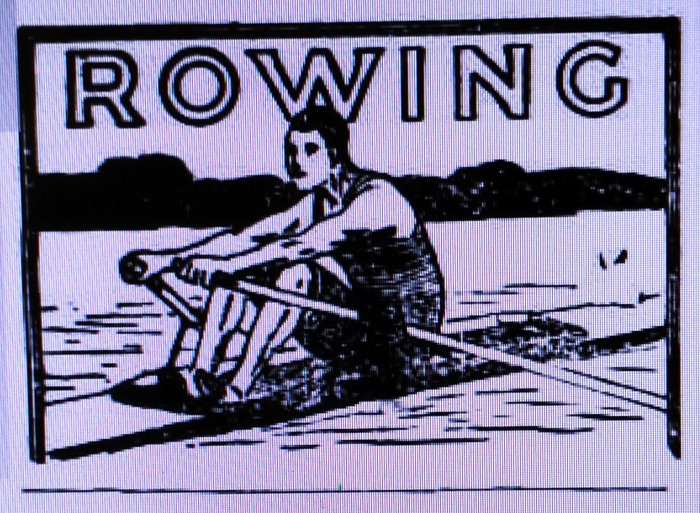
Rowing or sculling was one of the most popular and one of the oldest competitive sports in the world, at various amateur club levels, there was single sculling , team rowing, and the local championships.
There was also the professional national championships and professional world championship competitions, and both were big prize money events.
The world championships for this sport were dominated by the Australians, the Brit’s, New Zealanders, and the Canadians.
The Australian’s love of sport and the chance to have a wager on their favourite rower or maybe the outsider meant the public followed this sport with an enthusiasm similar to horse racing.
The sport had gained worldwide popularity and its contenders were gaining public adoration. Thousands of pounds were wagered by the public, race day spectators and race organizers, the competitors also having the chance of winning substantial prize money.
This was an attractive sport for anyone who showed some talent and Billy McDevitt was clearly developing his skill and building a name for himself in this popular sport.
There is uncertainty as to when Billy took up the sport of rowing, but having been born at Esperence at the mouth of the Huon River in Tasmania, the sport of rowing may have been a natural choice for Billy and his brother George.

In 1910 at the age of 24 Billy’s name and race credential’s first appeared in the local newspaper……….
SCULLING RACE AT HASTINGS – 27th December 1910
“The rowing race between William McDevitt and James Robertson took place today for a stake of 420. The course was one of three and half miles. McDevitt pulled a pretty race, and won easily. Considerable local interest was taken in the race.”
It wasn’t long after this news report that Billy made the move to New South Wales.
The young man from Tasmania had soon settled in Drummoyne Sydney and became a member of the Parramatta River Sculling Club. Between 1911 and 1914 Billy was successful in winning handicap events and starting to take home some of the winner’s purse.
Billy was now preparing himself for the bigger events and it wasn’t long before he had the opportunity to challenge some of the high profile professionals in the sport.
In January 1914 preparations for a professional race between Billy McDevitt and the highly regarded Syd Kemp was underway…’The Sydney Sportsman’ newspaper reported
“crossing of blades between Syd Kemp and Bill McDevitt. The two have been talking at each other for some time, but at last business was got down to, and articles signed for a race on February 28, over the full Parramatta River course, for £50 a-side. A fiver has been put up by each man and the second deposits, of £20 each, are to be lodged on February 1……if both are agreeable, the stakes may be increased to £100 a-side.”
In February of 1914 ‘The Referee’ another popular Sydney sporting newspaper reported….
McDEVITT v. KEMP.
“Wm. McDevitt and Syd Kemp are progressing well in training for their match to take place on the Parramatta River on the 21st lnst. To me It looks a splendid match, and it seemingly must be because there are just as many admirers of one as the other, Syd Kemp is fast and stays very well, whilst McDevitt is a great sticker and will assuredly stay it right out. Final deposits are due or the 20th inst.”
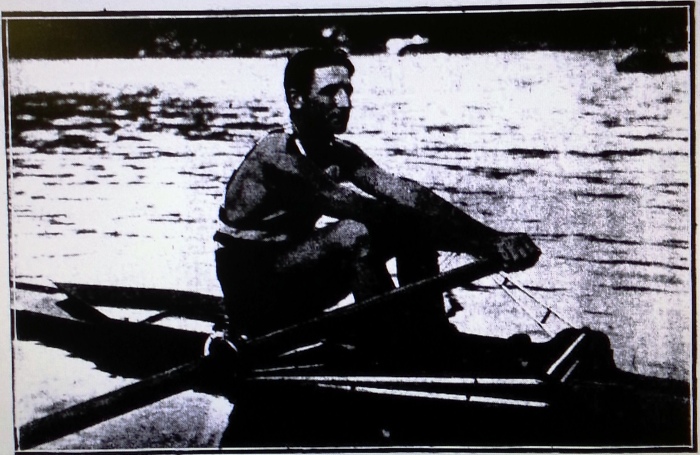
Syd Kemp at this point of his rowing career was in great winning form and was also the “pace “ rower for James Paddon the current Australian champion who in May 1914 later travelled to England to challenge Ernest Barry for the world championship.
On race day Billy McDevitt was described as “somewhat badly beaten”.
Although Billy had lost this important race, this was just the start of a very challenging journey towards a very successful sporting career.
By August 1914 Billy McDevitt’s sporting career was suddenly in doubt as larger events were taking place in Europe with the ‘Great War’.
By September 1914 amateur and professional rowing could not maintain its popularity as was the case with many sports and many fixtures were postponed due to the European hostilities and Australia’s call to war.
Before enlisting with the Australian Imperial Forces, Billy McDevitt married his longtime girlfriend Eleanor Mary Bartley from Hobart. They were married in Balmain, Sydney.
He was a late enlistment into the Field Engineers on the 29th September and was placed with the 1st Reinforcements as a driver under the watchful eye of the young Lieut. Henry Bachtold.
Lieut. Bachtold, was a large figure of a man, with a sporting background of his own and was Billy’s attesting officer and perhaps was familiar with Billy’s sporting reputation. Together with the 1st FCE 1st Reinf. they embarked on the HMT Berrima for war.


Billy’s original regimental number 714 was later changed to 227 when the 1st FCE Reinforcements merged with the original company in Egypt on the 25th February 1915.
Although Billy had not had the opportunity to spend time with the other originals at Moore Park prior to embarkation, his talents as an oarsman would prove to be vital and put to the ultimate test in the coming months.
On landing Day, Gallipoli, Billy was one of the 11 heroic engineers under the command of Lieut. Bachtold which rowed barrel piers ashore whilst under fire.
It is only stating the obvious why Billy McDevitt the only driver in the group, had been selected for this task, Lieut. Bachtold had not forgotten the gifted rower in the ranks.
For days the party of men would continue building jetties day and night, all the time being uncomfortably close at hand to witness some gruesome scenes among the casualties. The sea at the water’s edge was red with blood as the empty stretchers that had carried the many wounded were washed and rinsed in the sea next to them.
All the while keeping their heads and even having one of their own wounded in the face, the sappers continued building the landing stages and improving the landing conditions for the hospital and supply vessels under the same arduous conditions up to the 5th May.

This handful of men had helped save the lives of hundreds of fellow Anzacs and allied soldiers and were the rare few of the original engineers during the Gallipoli campaign who received “Mentioned in Orders”, Complimentary Orders and a few men would later add “Mentioned in Despatches” and further distinctions to their names.
Charles received a Complimentary Order for his gallantry. ( see below)

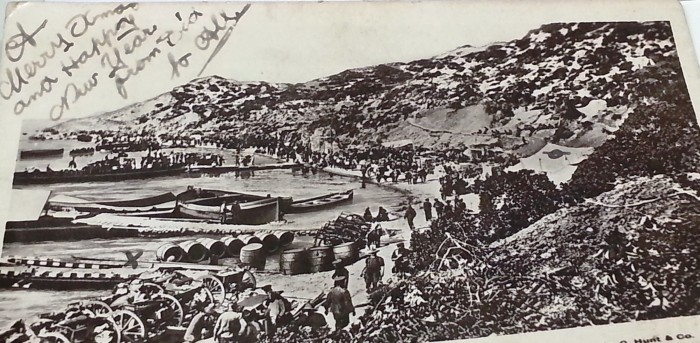
A full account of this important chapter in ANZAC history can be viewed in a previous posting following this link …..( Sapper’s save 1500 lives).
Billy McDevitt however was the unlucky member to be seriously wounded in the face.
On the 31st April 1915, a shrapnel wound shattered the bones in Billy’s face and he was shortly after discharged and returned to Australia in November 1915.
Billy McDevitt returned home, his facial injuries were severe and unfortunately he had been described as a hopeless case. Once he returned home he spent considerable time having reconstruction surgery.
The rowing world had not forgotten Billy McDevitt and in September 1916 a benefit Regatta day in honour of Billy was held by the Hunter River professional sculling club.
“After the loyal toasts had been honored, Mr. Norman Towns proposed the health of McDevitt, whom he described as one of the cleanest and one of the best in the rowing world.
Mr. Harold Judd, replying for McDevitt, said the latter would fully appreciate all they had done that day. McDevitt had twenty seven pieces of bone removed from his jaw, the result of a shrapnel wound and he hoped to go farming in Tasmania.”- Sydney Sportsman 27th Sept 1916
Farming may have been on his mind, but Billy McDevitt appears to have had some unfinished business and his severe wounds had simply diverted him from his course and still unsure of his military or sporting purpose, he re-enlisted in May 1918.
His attestation papers at this time bare witness to his original wounds suffered at Gallipoli. Fortunately it was late in the war and Billy did not embark.
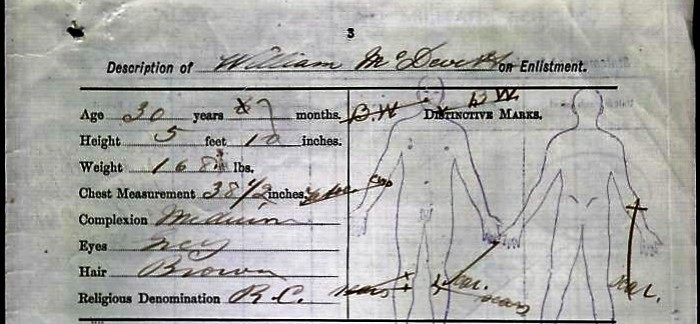 (Above : William McDevitt – 1918 Attestation, medical page showing position of bullet/shrapnel wounds)
(Above : William McDevitt – 1918 Attestation, medical page showing position of bullet/shrapnel wounds)
By 1919 the war was over and the world of sculling and the world championship races had returned and the glory days quickly returned along with vast number of supporters.
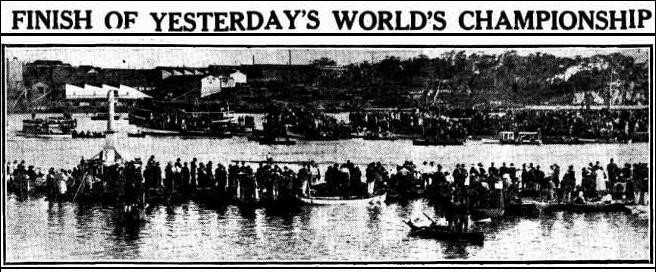 (Typical crowd on the river on race day)
(Typical crowd on the river on race day)
By the middle of 1920, with the wounds of war perhaps completely healed, Billy McDevitt had defied the odds and returned with great success to sculling and racing.
His first tilt at the Australian championship title was against the mighty James Paddon. Jim Paddon was the current Australian champion and like Billy had been waiting in the wings since 1914 to pick up where he left off.
Together they would compete for the Australian Championship. This was rowed on the Woodburn course, and although Paddon was a sick man on the day of the race he defeated McDevitt easily and retained the “Referee” cup.
The Sun – Sydney newspaper reported…..
IS McDEVITT A CHAMPION?
“Having beaten Billy Peterson, Reg Short, Jack Casey, and Syd Kemp In succession, the question whether Billy McDevitt is a champion is being asked among supporters of sculling. His performances certainly stamp him as something out of the ordinary, and now that he has made good, backing for important races can be found. Considering McDevitt was so badly smashed up during the war as to be termed a hopeless case, his recovery of form is extraordinary. He possesses those two qualifications so necessary in boat racing — strength and determination.” Sun – Sydney newspaper 13th May 1920
In 1922 Jim Paddon became world champion holding the title against 4 challenges over 3 consecutive years.

It took Billy McDevitt another four years to achieve the ultimate rowing success, and in June 1924 at Dargaville, New Zealand he made Australian and professional sculling race history.
SCULLING CHAMPIONSHIP.
McDEVITT THE WINNER. GOOD RACE ON NORTHERN WAIROA.
Yesterday’s race on the Northern Wairoa River for the Australian and New Zealand sculling championship was probably unique in the history of rowing in that four aspirants for championship honours participated. It was a great day in Dargaville, and practically the whole of the population of the town, augmented by a big contingent of visitors from the country districts and from the city, witnessed the race and assisted in acclaiming McDevitt the winner..……NZ – ‘Northern Advocate’ 11th June 1924 – (http://paperspast.natlib.govt.nz/newspapers/NA19240611.2.58)
In 1924 perhaps feeling he had earned his place in rowing history, the great rowing world champion Jim Paddon declined to defend his title and the rules of professional rowing meant that the title of world champion was passed onto the next eligible challenger. As Billy McDevitt had made his challenge to Paddon known and was the current reigning Australian Champion title holder after winning at Dargaville in New Zealand, Billy McDevitt therefore secured the title of World Champion by forfeit.
Billy McDevitt was now the world champion.
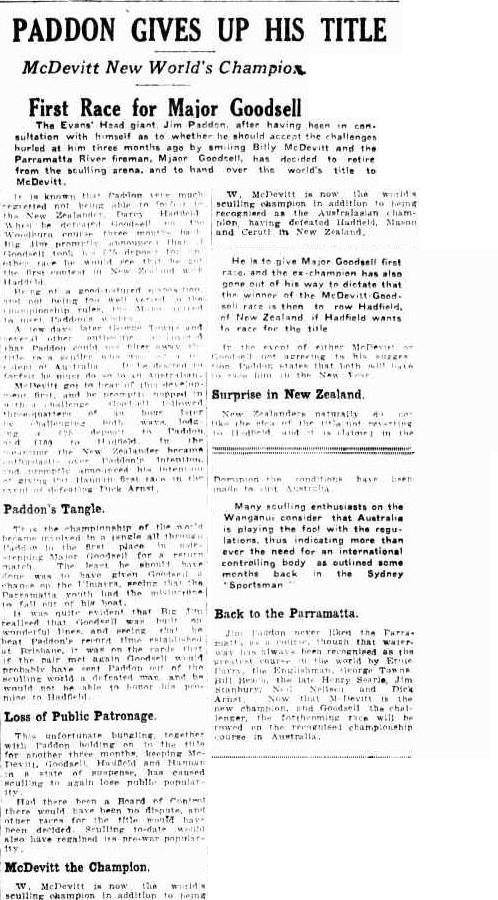
Billy’s title of world champion was short lived and at the age of 38 his title was quickly contested.
The world championship title challenge was taken up by Major Goodsell, the race was run on the Clarence River near Ullmarra on 21 March 1925. The stake was £250 a side….. and Billy McDevitt was defeated. Critics were surprised by the loss as Billy was considered the favourite.
Billy had made a very good living from his sport. He was a popular sports figure and at the height of his career newspapers had made references to him being ” the most popular man in New South Wales”.
The great James Padden also returned to racing but never regained the title.
Perhaps his war torn body had finally caught up with him, but for many years Bill continued competitive rowing and remained a carpenter and family man.
Billy and Eleanor had settled in West Ryde New South Wales with their four sons and two daughters for many years. In 1934 Eleanor died 18th July 1934.

In 1954 the electoral rolls show that Billy had returned to Tasmania and he was living at 20 Salvator Rd, Denison Hobart West and was still a builder. Living nearby is Amy Margaret McDevitt.

Billy Charles William McDevitt died on 20th May 1970 in Hobart .. he was 82 years old.
Story © VanceKelly2016
Sources & Acknowledgements
AWM, NLA, NAA
‘Papers Past’ – National Library New Zealand Govt.
Photo – Original Christmas postcard from 124 Sid Garrett collection – courtesy Long Jetty RSL Museum.
Family Notes
Billy enlisted and declared his age as 26 and born in Parkes, neither was true. He was 28 and born in Esperence Tasmania. The reason for the error is perhaps clerical as Billy had no reason to alter his details as he declared his marriage and his wife as NOK and address.
Eva Muller Southcombe born 1952 on ancestry.com.. she is married to Phillip Southcombe
Ancestry.com also shows a grandson and a grand daughter Kerry McDevitt.
Son Charles Bartley McDevitt – married Gloria Marion Kelso Shortus in Ryde 1955 –
Possibly son named Leslie Edward died 1984
In July 1915 younger brother Edward Harold McDevitt Enlisted he was 21 and embarked with the 26th Battalion 4th Reinf. He was wounded in action but returned safely in 1919 ( he died in 1971 buried Cornelian Bay Cemetery)


